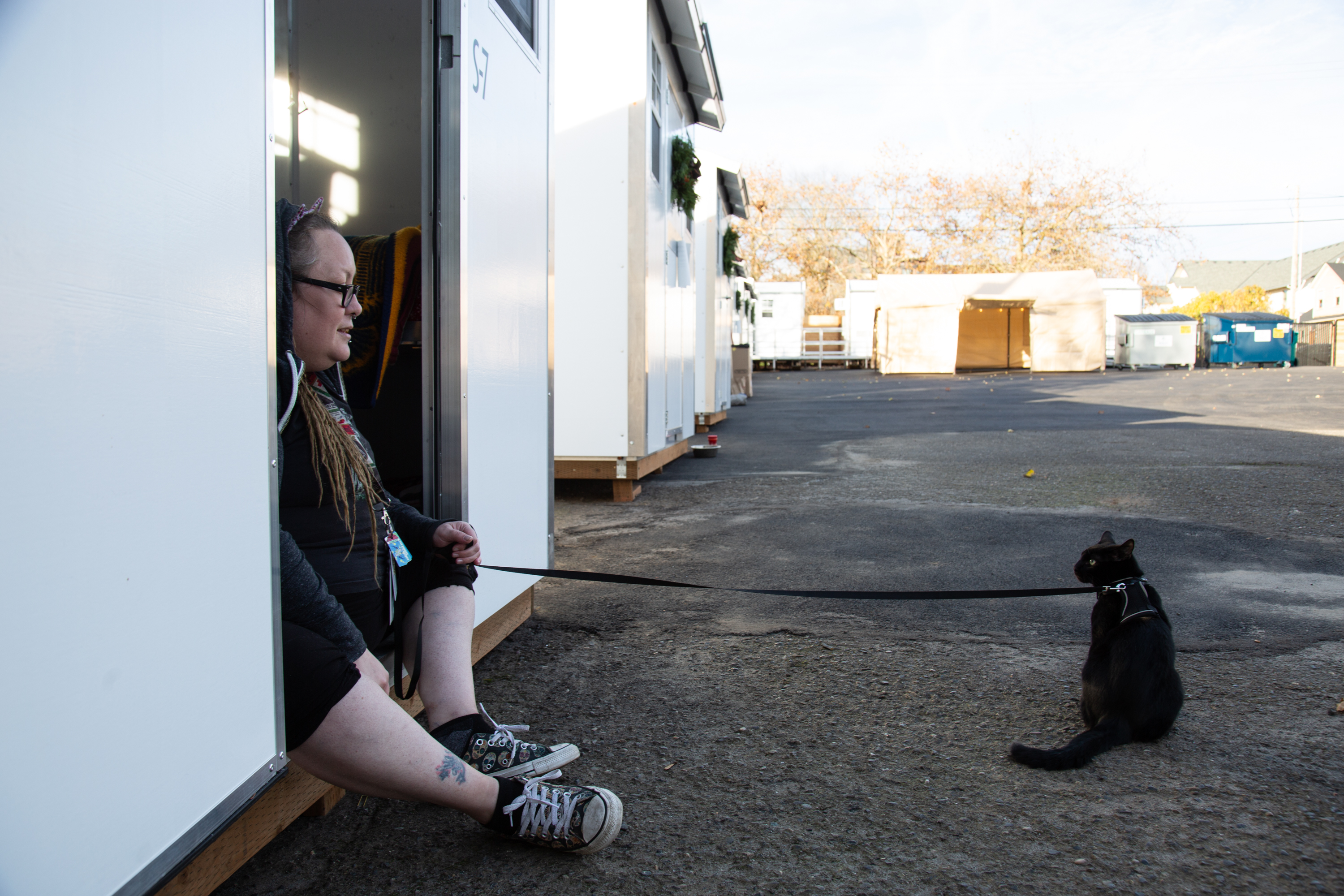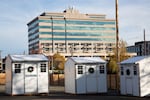
Sharleyin Corbett sits at her home as part of the new Safe Stay community at 415 West 11th Street, Vancouver, Wash., on Nov. 21, 2023. The city of Vancouver opened the village several days ago.
Troy Brynelson / OPB
Alucard and Severus — a pair of black cats, harnessed and leashed to the hands of Sharleyin Corbett — bounced over the threshold of their new home and onto the pavement.
Then they zipped back inside, and back out again. Again and again, they repeated the maneuver, the way cats do when there are endless new sights and smells to absorb.
When one padded the pavement to the end of the leash, Corbett, 44, joked the cat “obviously” already wanted a bigger space.
“This is the first time I’ve had a home,” she said of her new 8-by-8-foot cabin. “We love it.”
The trio are among the first residents at the city of Vancouver’s newest village of tiny homes. The villages — called Safe Stay communities by city officials — are meant to put a roof over unhoused residents and give them the stability they missed living on the streets or in cars.
The new site is called “415 West,” named after its location at 415 West 11th Street. It’s Vancouver’s third Safe Stay and its first in the city’s downtown area. There are 20 shelters, each of which can house one or two people. The new village also offers on-site laundry and showers.
Related: Vancouver reveals location for first outdoor ‘Safe Stay Community’ for city’s homeless
After spearheading three tiny home-style shelter villages and spending at least $4 million dollars, city officials continue to view them positively. They don’t typically serve the hardest-to-house subgroup of unhoused people, but do aid people who are closer to finding a job or a house but have very limited resources.
“This kind of shelter model works very well for a specific type of person,” said Jamie Spinelli, Vancouver’s homeless response manager.

Pallet shelters stand at 415 West 11th Street, Vancouver, Wash., on Nov. 21, 2023.
Troy Brynelson / OPB
City is planning dorm-style shelter with treatment services
The Safe Stay facilities operate on temporary permits, meaning elected officials will have to decide their futures in the coming years. In addition to 415 West, the city operates similar shelter sites at its other two locations in central Vancouver.
Going forward, the city’s initiatives around homelessness are set to draw more attention. On Nov. 6, Vancouver City Council declared homelessness an emergency. That decision vests the city with more powers, such as bypassing typical public processes around hiring people or signing contracts.
The emergency declaration also is teeing up a major focus for Spinelli next year: a large, dorm-style shelter. Spinelli said the planning stage is just beginning, and there are no details yet on what it will look like or where it will be located.
Related: Vancouver considers 2 new ‘Safe Stay’ sites for homeless people after initial successes
But Spinelli said one thing is clear: The shelter will be a more ambitious swing to get unhoused people connected with services, like treatment for substance abuse or medication, or to find housing.
“The goal is for that to have much more on-site, immediate access to things that are needed for stability,” Spinelli said.
She added that more than two dozen people died in Vancouver last year while experiencing homelessness.
The Safe Stays, meanwhile, have given shelter to 186 people. Forty-eight people have found work, and 73 people have moved into stable housing. Spinelli said an average person spends at least three months living in one of the shelters.
Related: Southwest Washington leaders say fentanyl prompting shifts in homelessness rules
Corbett, with her cats, said her shelter is the first private space she’s had in years. She doesn’t suffer from mental illness or substance abuse, she said, but is a survivor of domestic violence.
To her, the Safe Stay is a stepping stone. She said she hopes to get an apartment next year.
“After all this is said and done, I would love to come back and volunteer. Like, totally pay it forward,” Corbett said.
Officials plan to open a fourth Safe Stay in December.

